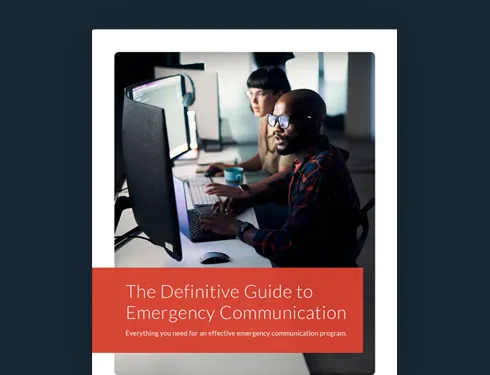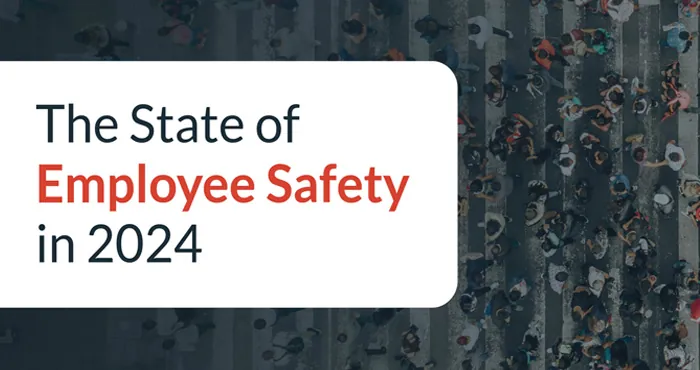
9 Expert Strategies to Level Up Safety Communication in 2025
When it comes to workplace safety, you can’t afford small communication mistakes like missed messages or misunderstandings. Learn how to better inform—and thus protect—your employees through improved safety communication.

Safety matters. But so does good communication. You can have the best plans and procedures in place—but if your employees don’t know how to execute them, their safety may be compromised.
With 79% of American employees feeling increasingly anxious about their health and well-being, employers have a duty of care to promote workplace safety throughout the organization. Whether employees are working in an office, remotely from home, on a remote construction site, or traveling to a foreign country, communication is the cornerstone of safety.
AlertMedia’s experts—supported by the experiences of our customers and real-world safety leaders—have put together a selection of nine safety communication strategies. Discover how to create a workplace where safety is paramount and how promoting safety communication best practices protects your people and your business.
The Definitive Guide to Emergency Communication

What Role Does Communication Play in Safety?
Critical communication is a foundational aspect of workplace safety. Even the most robust emergency preparedness plan will fail if you can’t effectively communicate it to your employees. Ron Derrick, Corporate Senior Emergency Manager at Whataburger agrees, saying, “The way we control chaos during an emergency is through communication.”
This approach was brought into sharp focus when Derrick received information from AlertMedia’s threat intelligence solution that a nearby active shooter situation threatened the safety of Whataburger’s frontline employees. “Thanks to the speed of AlertMedia’s intelligence alerts, we were able to communicate with our family members (employees) immediately—before the police even knocked on the door,” says Derrick.
Examples like this illustrate why communication is critical. And effective communication not only boosts employee morale—it also improves safety performance, overall productivity, and business continuity.
So, how can organizations demonstrate their commitment to safety? It starts with timely, transparent, open communication.
What Is Effective Safety Communication?
Effective safety communication tells your employees what they need to do to stay safe before, during, and after an incident or emergency. This communication should be fast, accurate, informative, and relevant. Communication is also most effective when it is proactive as well as reactive. Safety outcomes improve, and employee engagement increases when employees feel prepared, confident, and supported throughout an emergency.
Effective safety communication is a vital component of building a safety culture. It strengthens employee safety by ensuring employees:
- Understand their roles and responsibilities in an emergency
- Are aware of emerging and ongoing threats
- Know how to avoid unsafe practices and exposure to hazardous threats
Safety communication can take many forms—from safety policy updates and safety moments to in-depth safety training and more—but what’s important is that it is clear, consistent, and accessible to all employees.
9 Strategies for Safety Communication in the Workplace
Ready to level up your safety communication? We’ve rounded up nine strategies that help break down communication barriers and promote a positive safety culture in which all employees feel informed at all times and accountable to safe operations.
You’ll also find real-world examples from experts demonstrating how safety management communication has made a real difference in their organization—offering an inspiring example of what’s possible when communication is done right.
1. Reach the right people with targeted messaging
When a crisis hits, you need to reach the right people at the right time. Messages that apply to only a subset of employees but are distributed too broadly can end up overloading your employees with too much information and diluting the impact of the safety messages that really matter. Avoid those negative consequences. Instead, shift to using an advanced emergency communication system that allows you to send targeted messages. Using AlertMedia, says Michael Hunt, ERP Systems and IT Manager at FCC, “The ability to create dynamic groups with multiple administrators saves us time and enables a much more deliberate, thoughtful approach to employee communication.”
Employees who are traveling or working in a remote location don’t need to receive notifications about an extreme weather event happening hundreds of miles away—but it’s critical to communicate with the employees who may be impacted. “By segmenting our audience in a number of different ways—such as by county, department, employment status, and more—we are prepared for any situation we may need to communicate about,” adds Hunt.
2. Discuss psychological safety openly
Employees are expecting more from their workplaces—and with good reason. Eighty-three percent of Americans have experienced a critical incident in the workplace. They want to know their employer is working to keep them physically and psychologically safe. Prioritizing the mental health of your employees can increase productivity and retention while alleviating stress and anxiety.
Creating psychological safety in the workplace can look like mental healthcare options in your medical benefits, creating flexible work schedules that allow for a better work-life balance, and encouraging regular physical activity. “We need to create environments where people feel safe to express themselves, to have healthy conflict, to share when they don’t think something is right, without fear of consequences,” advises David Hassell, co-founder of 15Five.
3. Fill communication gaps for remote and hybrid employees
Remote and hybrid work is here to stay. Communication strategies need to flex to accommodate the challenges raised by this new way of working. Whether remote workers are in a home office or on the road, effectively communicating with a dispersed workforce comes with challenges that traditional communication methods can’t always meet.
Integrating remote work communication best practices into your communication strategy—like correctly categorizing your workforce and keeping messages relevant—can ensure your messages get to the right employees at the right time.
“Our remote workers are spread out geographically, and we needed a way to quickly identify events happening across various locations,” says Lauren Campbell, Director of Emergency Preparedness, Visiting Nurse Service of New York. “AlertMedia allows us to visualize all our employees within a certain radius of an incident, monitor whether it’s becoming an increasingly unsafe situation, and then send instant notifications out to those specific staff members.”
4. Use location-based weather alerts
Extreme weather events and natural disasters are becoming more frequent and more intense. And often, they strike with little warning. Using location-based weather alerts is the best way to prepare your employees for emerging weather threats—whether that’s a snowstorm disrupting their commute to the office or a hurricane predicted to hit a location they’re traveling to for work.
Providing up-to-date, relevant information allows employees to make informed choices, adjust travel plans, and stay safe. “There’s no way we could have kept our people safe from this Category 4 hurricane without AlertMedia,” says Scott Gerard, Vice President of Environmental, Health & Safety (EHS) at Moss Construction. ”Email would have taken too long, and phone circuits were already faltering. With AlertMedia, we were able to account for and ensure all employees were in a safe location prior to the storm.”
5. Draft notification templates for emergencies
When an emergency hits, every second counts. Instead of scrambling to write an alert that needs to be sent out right now, take the time to draft a range of notification templates to suit various scenarios you’ve identified as potential risks to your employees—from hazard communication to lockdown alerts.
One example of an emergency notification template is:
“There is a [type of emergency] in [location]. This is NOT a drill. Proceed to the nearest evacuation route and leave the building immediately.”
The emergency planning committee at the multinational food manufacturer Ingredion did just that. “We assessed the types of threats we might face, and we created a template for each of those. We also use event pages to store our Crisis Management Plans. This allows our Crisis Management team to have quick and easy access to the Crisis Management Plan using their AlertMedia mobile application. Time is of the essence, so we need to be able to act quickly,” says John Hoekstra, Senior Manager for Global Health, Safety & Security at Ingredion.
6. Proactively address accessibility and language barriers
One in four Americans has a disability, and one in five speaks a language other than English at home. Any workplace safety communications need to accommodate all employees equally. Emergency plans need to include accessibility measures to meet the guidelines issued by the U.S. Equal Employment Opportunity Commission (EEOC).
Accommodations on a day-to-day basis include things like wheelchair ramps and screen readers—but your internal communication system should also include provisions that ensure communications are accessible to all. Segmenting employees into groups who prefer to receive emergency communications in their native language can aid comprehension in a crisis. You should also evaluate evacuation routes for their suitability for staff with specific requirements like wheelchair access and provide alternatives when necessary.
7. Maintain an open channel for employee feedback
Often, employees are the ones who have the best insights into the effectiveness of safety procedures. What works on paper for you might not work in practice for them. Allowing employees to have a say in safety plans makes it easier to identify gaps. All employees should feel confident raising safety concerns, reporting potential hazards, and stopping working when they discover an issue. Conducting emergency drills and simulated tabletop exercises can help employees identify and share feedback on what aspects of emergency response plans they feel need improvement. Implementing a 24-hour emergency hotline is also a great way to ensure employees can always contact a live person for help and guidance—from anywhere at any time.
One vital part of developing a healthy workplace safety culture is ensuring employee buy-in. By building open channels for the bidirectional exchange of information, like two-way communication, employees feel empowered to raise concerns and know that their opinions matter. Ron Derrick of Whataburger says that using an emergency communication system with “two-way survey functionality allows us to ask questions of our family members in the field to discover insights that we can’t gather from corporate headquarters alone.”
8. Commit to formalized, documented communication in safety plans
Details about how an organization communicates during a crisis are often embedded within overarching emergency planning documents. But it’s worth creating a separate crisis communication plan. By clearly laying out the procedures and messages that will guide how you react to an emergency, you can ensure you’re responding proactively rather than reactively.
Ninety-five percent of business leaders want to improve their ability to respond to and manage crises effectively. To do so, gaining clarity around communication skills during a crisis is an essential first step. Assess and update these plans frequently, particularly after a crisis when improvements are easiest to identify. “We are constantly promoting preparedness and finding ways to engage our teams,” says Penny Neferis, Director of Business Continuity, Disaster Recovery, and Emergency Response at JetBlue Airways. “You can’t let your emergency plans sit and collect dust. Having an active program is essential to keeping employees safe.”
9. Schedule regular safety moments
Long, tedious health and safety meetings can actually lead employees to switch off. In fact, most audiences tune out within just 10 minutes. Using regularly scheduled but short and sharp “safety moments” is a much better way to offer up critical safety information in an easily digestible format.
Some safety moment ideas to incorporate include:
- Emergency exits and routes
- Fire prevention and preparedness
- Safety tips for avoiding slips, trips, and falls
- Cybersecurity
- The importance of regular breaks
Safety moments have a similar purpose to the “toolbox talks” favored by work environments like construction sites to quickly communicate safety procedures that can regularly be changed or updated. You might also see these talks called tailgate meetings, safety chats, or safety minutes. Whatever your organization chooses to call them—these snippets of information are an effective way to keep employees engaged, informed, and prepared.
Putting Safety Communication on Your 2024 Agenda
Employees expect—and deserve—the best safety communication from their employers. Whether you need to clearly explain your safety plans for a range of critical incidents or send regular messages letting your employees know what you’re doing to protect them, it’s time to put communication in the spotlight.
With an effective safety communication strategy—backed by the right emergency communication platform—you can ensure employees always feel engaged, informed, and empowered to take the right actions quickly when emergencies strike.




